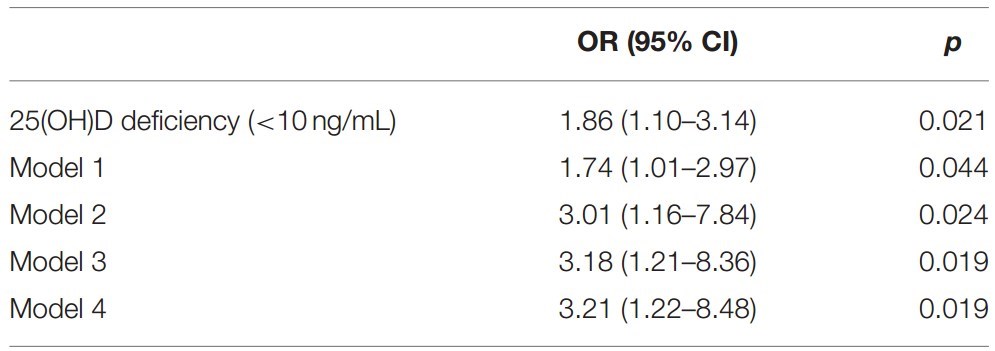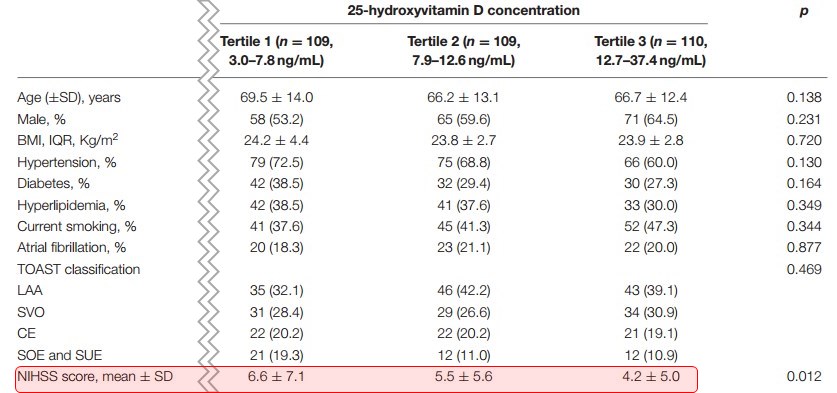Stroke outcome at 3 months was 3X worse if bad stroke and low vitamin D
Impact of 25-Hydroxyvitamin D on the Prognosis of Acute Ischemic Stroke: Machine Learning Approach.
Front Neurol. 2020 Jan 31;11:37. doi: 10.3389/fneur.2020.00037. eCollection 2020.
Kim C1,2, Lee SH1, Lim JS3, Kim Y4, Jang MU5, Oh MS3, Jung S6, Lee JH4, Yu KH3, Lee BC3.
 ---
1. VitaminDWiki: Stroke Meta-analyses
{category}
---
1. Mega-dosing Vitamin D helps a lot (note: injection is not required)
* Improved recovery from ischemic stroke with Vitamin D (300,000 IU injection) – RCT June 2018
* Ischaemic stroke – Vitamin D doubled survival (Injection followed by monthly 60,000 IU) – RCT Aug 2016
---
1. VitaminDWiki: Stroke Meta-analyses
{category}
---
1. Mega-dosing Vitamin D helps a lot (note: injection is not required)
* Improved recovery from ischemic stroke with Vitamin D (300,000 IU injection) – RCT June 2018
* Ischaemic stroke – Vitamin D doubled survival (Injection followed by monthly 60,000 IU) – RCT Aug 2016
📄 Download the PDF from VitaminDWiki

Model 1 was adjusted for age and sex.
Model 2 included variables in model 1 plus NIHSS and NIHSS*25-hydroxyvitamin D deficiency interaction term.
Model 3 included variables in model 2 plus stroke subtype (TOAST classification) and intravenous thrombolysis.

Background and Purpose: Vitamin D is a predictor of poor outcome for cardiovascular disease. We evaluated whether serum 25-hydroxyvitamin D level was associated with poor outcome in patients with acute ischemic stroke (AIS) using machine learning approach.
Materials and Methods: We studied a total of 328 patients within 7 days of AIS onset. Serum 25-hydroxyvitamin D level was obtained within 24 h of hospital admission. Poor outcome was defined as modified Rankin Scale score of 3-6. Logistic regression and extreme gradient boosting algorithm were used to assess association of 25-hydroxyvitamin D with poor outcome. Prediction performances were compared with area under ROC curve and F1 score.
Results: Mean age of patients was 67.6 ± 13.3 years. Of 328 patients, 59.1% were men. Median 25-hydroxyvitamin D level was 10.4 (interquartile range, 7.1-14.8) ng/mL and 47.2% of patients were 25-hydroxyvitamin D-deficient (<10 ng/mL). Serum 25-hydroxyvitamin D deficiency was a predictor for poor outcome in multivariable logistic regression analysis (odds ratio, 3.38; 95% confidence interval, 1.24-9.18, p = 0.017). Stroke severity, age, and 25-hydroxyvitamin D level were also significant predictors in extreme gradient boosting classification algorithm. Performance of extreme gradient boosting algorithm was comparable to those of logistic regression (AUROC, 0.805 vs. 0.746, p = 0.11).
Conclusions: 25-hydroxyvitamin D deficiency was highly prevalent in Korea and low 25-hydroxyvitamin D level was associated with poor outcome in patients with AIS. The machine learning approach of extreme gradient boosting was also useful to assess stroke prognosis along with logistic regression analysis.
